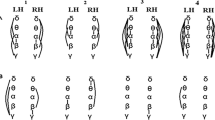In 10 tested dextral subjects, EEG activity was recorded during the performance of unimanual and bimanual cyclic movements of the hands and fingers. The movements corresponded to clenching the fingers into a fist and the subsequent unclenching of the fingers. The test consisted of four successive stages, the resting state, movement of the left hand, that of the right hand, and movement of both hands. The dependences between the spectral power and coherence of the respective EEG samples on the type of the test performed, on the type of the movement (uni- or bimanual), and on the laterality of the latter in the case of the unimanual movement were examined. The results obtained allow us to propose the following conclusions: (i) α and β EEG rhythms are characterized by different functional importance with respect to manual motor activity; (ii) neural control of bimanual movements cannot be considered “a sum of the controls” of unimanual movements, and (iii) control of bimanual movements may be largely based on the control of the movement by a subdominant upper limb.
Similar content being viewed by others
References
N. V. Dounskaia, K. G. Nogueira, S. P. Swinnen, and E. Drummond, “Limitations on coupling of bimanual movements caused by arm dominance: When the muscle homology principle fails,” J. Neurophysiol., 103, No. 4, 2027-2038 (2010).
T. I. Abramovich, A. V. Gorkovenko, I. V. Vereshchaka, et al., “Peculiarities of activation of human muscles in realization of cyclic bimanual movements with different organization of the cycles,” Neurophysiology, 48, No. 1, 31-42 (2016).
J. Long, T. Tazoe, D. S. Soteropoulos, and M. A. Perez, “Interhemispheric connectivity during bimanual isometric force generation,” J. Neurophysiol., 115, 1196- 1207 (2015).
D. J. Serrien and M. M. Sovijärvi-Spapé, “Hemispheric asymmetries and the control of motor sequences,” Behav. Brain Res., 283, 30-36 (2015).
B. A. Kay, J. A. Kelso, E. L. Saltzman, and G. Schoener, “Space-time behavior of single and bimanual rhythmical movements: data and limit cycle model,” J. Exp. Psychol. Human Percept. Perform., 13, No. 2, 178-192 (1987).
S. C. de Oliveira, “The neuronal basis of bimanual coordination: recent neurophysiological evidence and functional models,” Acta Psychol., 110, Nos. 2/3, 139-159 (2002).
J. D. Wong, E. T. Wilson, D. A. Kistemaker, and P. L. Gribble, “Bimanual proprioception: are two hands better than one?” J. Neurophysiol., 111, No. 6, 1362-1368 (2014).
Y. Li, O. Levin, A. Forner-Cordero, R. Ronsse, and S. P. Swinnen, “Coordination of complex bimanual multijoint movements under increasing cycling frequencies: the prevalence of mirror-image and translational symmetry,” Acta Psychol., 130, No. 3, 183-195 (2009).
V. Garkavenko, O. Man’kovskaya, T. Omel’chenko, et al., “Effect of cold stimulation of the arm fingers on the spectral/coherent EEG characteristics in humans,” Neurophysiology, 40, No. 3, 228-230 (2008).
V. Garkavenko, E. Man’kovskaya, T. Omel’chenko, et al., “Modifications of EEG in humans performing cyclic movements by the fingers of the right arm: Effect of local contralateral cooling,” Neurophysiology, 40, Nos. 5/6, 369-376 (2008).
C. Gerloff, J. Richard, J. Hadley, et al., “Functional coupling and regional activation of human cortical motor areas during simple, internally paced and externally paced finger movements,” Brain, 121, No. 8, 1513-1531 (1998).
S. Schaal, D. Sternad, R. Osu, and M. Kawato, “Rhythmic arm movement is not discrete,” Nat. Neurosci., 7, No. 10, 1136-1143 (2004).
E. G. James, “Nonstationarity of stable states in rhythmic bimanual coordination,” Motor Control, 18, No. 2, 184-198 (2014).
R. R. Walsh, S. L. Small, E. E. Chen, and A. Solodkin, “Network activation during bimanual movements in humans,” NeuroImage, 43, No. 3, 540-553 (2008).
M. Toyokura, I. Muro, T. Komiya, and M. Obara, “Relation of bimanual coordination to activation in the sensorimotor cortex and supplementary motor area: analysis using functional magnetic resonance imaging,” Brain Res. Bull., 48, No. 2, 211-217 (1999).
F. G. Andres, T. Mima, A. E. Schulman, et al., “Functional coupling of human cortical sensorimotor areas during bimanual skill acquisition,” Brain, 122, No. 5, 855-870 (1999).
M. A. Perez, D. S. Soteropoulos, and S. N. Baker, “Corticomuscular coherence during bilateral isometric arm voluntary activity in healthy humans,” J. Neurophysiol., 107, No. 8, 2154-2162 (2012).
T. W. Boonstra, “The potential of corticomuscular and intermuscular coherence for research on human motor control,” Front. Human Neurosci., 7, 855 (2013).
B. A. Conway, D. M. Halliday, S. F. Farmer, et al., “Synchronization between motor cortex and spinal motoneuronal pool during the performance of a maintained motor task in man,” J. Physiol., 489, No. 3, 917-924 (1995).
A. M. Amjad, D. M. Halliday, J. R. Rosenberg, and B. A. Conway, “An extended difference of coherence test for comparing and combining several independent coherence estimates: theory and application to the study of motor units and physiological tremor,” J. Neurosci. Methods, 73, No. 1, 69-79 (1997).
A. de Rugy and D. Sternad, “Interaction between discrete and rhythmic movements: reaction time and phase of discrete movement initiation during oscillatory movements,” Brain Res., 994, No. 2, 160-174 (2003).
K. von Carlowitz-Ghori, Z. Bayraktaroglu, F. U. Hohlefeld, et al., “Corticomuscular coherence in acute and chronic stroke,” Clin. Neurophysiol., 125, No. 6, 1182-1191 (2014).
Author information
Authors and Affiliations
Corresponding author
Rights and permissions
About this article
Cite this article
Tomiak, T., Gorkovenko, A.V., Mishchenko, V.S. et al. Features of EEG Activity Related to Realization of Cyclic Unimanual and Bimanual Hand Movements in Humans. Neurophysiology 49, 78–89 (2017). https://doi.org/10.1007/s11062-017-9632-z
Received:
Published:
Issue Date:
DOI: https://doi.org/10.1007/s11062-017-9632-z



